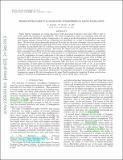| dc.contributor.author | Seager, Sara | |
| dc.contributor.author | Bains, William | |
| dc.contributor.author | Hu, Renyu | |
| dc.date.accessioned | 2014-03-28T14:06:20Z | |
| dc.date.available | 2014-03-28T14:06:20Z | |
| dc.date.issued | 2013-11 | |
| dc.date.submitted | 2013-04 | |
| dc.identifier.issn | 0004-637X | |
| dc.identifier.issn | 1538-4357 | |
| dc.identifier.uri | http://hdl.handle.net/1721.1/85944 | |
| dc.description.abstract | Super-Earth exoplanets are being discovered with increasing frequency and some will be able to retain stable H2-dominated atmospheres. We study biosignature gases on exoplanets with thin H2 atmospheres and habitable surface temperatures, using a model atmosphere with photochemistry and a biomass estimate framework for evaluating the plausibility of a range of biosignature gas candidates. We find that photochemically produced H atoms are the most abundant reactive species in H2 atmospheres. In atmospheres with high CO2 levels, atomic O is the major destructive species for some molecules. In Sun-Earth-like UV radiation environments, H (and in some cases O) will rapidly destroy nearly all biosignature gases of interest. The lower UV fluxes from UV-quiet M stars would produce a lower concentration of H (or O) for the same scenario, enabling some biosignature gases to accumulate. The favorability of low-UV radiation environments to accumulate detectable biosignature gases in an H2 atmosphere is closely analogous to the case of oxidized atmospheres, where photochemically produced OH is the major destructive species. Most potential biosignature gases, such as dimethylsulfide and CH3Cl, are therefore more favorable in low-UV, as compared with solar-like UV, environments. A few promising biosignature gas candidates, including NH3 and N2O, are favorable even in solar-like UV environments, as these gases are destroyed directly by photolysis and not by H (or O). A more subtle finding is that most gases produced by life that are fully hydrogenated forms of an element, such as CH4 and H2S, are not effective signs of life in an H2-rich atmosphere because the dominant atmospheric chemistry will generate such gases abiologically, through photochemistry or geochemistry. Suitable biosignature gases in H2-rich atmospheres for super-Earth exoplanets transiting M stars could potentially be detected in transmission spectra with the James Webb Space Telescope. | en_US |
| dc.language.iso | en_US | |
| dc.publisher | Institute of Physics Publishing | en_US |
| dc.relation.isversionof | http://dx.doi.org/10.1088/0004-637x/777/2/95 | en_US |
| dc.rights | Creative Commons Attribution-Noncommercial-Share Alike | en_US |
| dc.rights.uri | http://creativecommons.org/licenses/by-nc-sa/4.0/ | en_US |
| dc.source | arXiv | en_US |
| dc.title | BIOSIGNATURE GASES IN H₂-DOMINATED ATMOSPHERES ON ROCKY EXOPLANETS | en_US |
| dc.type | Article | en_US |
| dc.identifier.citation | Seager, S., W. Bains, and R. Hu. "BIOSIGNATURE GASES IN H₂-DOMINATED ATMOSPHERES ON ROCKY EXOPLANETS." The Astrophysical Journal, 777:2 (2013). pp.1-19. | en_US |
| dc.contributor.department | Massachusetts Institute of Technology. Department of Earth, Atmospheric, and Planetary Sciences | en_US |
| dc.contributor.department | Massachusetts Institute of Technology. Department of Physics | en_US |
| dc.contributor.mitauthor | Hu, Renyu | en_US |
| dc.contributor.mitauthor | Seager, Sara | en_US |
| dc.contributor.mitauthor | Bains, William | en_US |
| dc.relation.journal | Astrophysical Journal | en_US |
| dc.eprint.version | Author's final manuscript | en_US |
| dc.type.uri | http://purl.org/eprint/type/JournalArticle | en_US |
| eprint.status | http://purl.org/eprint/status/PeerReviewed | en_US |
| dspace.orderedauthors | Seager, S.; Bains, W.; Hu, R. | en_US |
| dc.identifier.orcid | https://orcid.org/0000-0002-6892-6948 | |
| mit.license | OPEN_ACCESS_POLICY | en_US |
| mit.metadata.status | Complete | |
